Cover Story
Daniel Atkinson: Renaissance Man
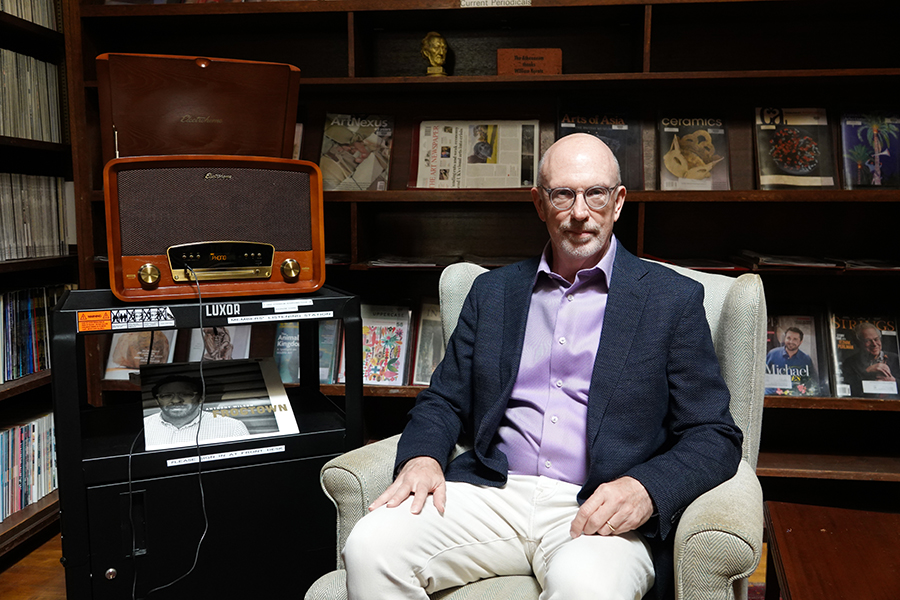
Daniel Atkinson. Photo by Chuck Lapinsky.
I first met Dan Atkinson in person some 13 years ago, on a bright sunny afternoon at the now defunct KSDS/Ocean Beach Jazz Festival, although I’d been attending his events (he’s been the jazz program coordinator for the La Jolla Athenaeum) for more than 30 years. These concerts have always been pristine examples of how America’s only indigenous art form should be presented.
Athenaeum productions feature stellar acts from the national and international milieu, and each concert exudes a sense of class, conducted in venues that reflect the importance of the music. Dan acts as the emcee, charming the audience with his erudite and soothing voice, introducing artists from all over the globe. When it comes to Atheneum events, my only regrets center around the events I’ve been unable to attend.
I confessed as much to Dan when we met on that fortuitous day way back when. I had been writing about jazz for just a few years and had yet to achieve the status of being extended a press pass to all important local events, and sometimes economics prevented me from attending everything I wanted to see. I wasn’t exactly Nat Hentoff at that point, but Dan was aware of my work, and he generously invited me to any show I was interested in, no small gesture since these concerts frequently sell out. In the intervening years, I have slowly gotten to know the man and have come to deeply appreciate the support of such a learned and accomplished fellow. Dan doesn’t just present unforgettable concerts of the ne plus ultra variety, he is also a polymath with an impressive academic background, who served as the director of arts, humanities, and languages at UCSD Extension for many years. He also founded the much-heralded UCSD Jazz Camp in 2003, which boasted a faculty featuring iconic talents like Charles McPherson, Mark Dresser, Anthony Davis, Holly Hofmann, Peter Sprague, and more. The Jazz Camp consistently turned out musicians whose potential soared into the national consciousness (a couple of prime examples being pianist Joshua White and bassist John Murray).
Over the last 30 years I’ve been blown away by the magnitude of the musical artists Daniel has brought to San Diego. During that timeframe, he’s presented giants like Charlie Haden, McCoy Tyner, Charles Lloyd, Kenny Wheeler, Dave Holland, and Jeff Ballard (I felt myself levitating in my seat for that one) to our sleepy town.
Back in 2018, I had the distinct honor of nominating Daniel Atkinson for the title of Jazz Hero on behalf of the internationally based Jazz Journalists Association, an award richly deserved. As a consequence, the mayor of the city of San Diego declared April 4 to be Daniel Atkinson Day, and I got to present him his award in front of a sold-out Athenaeum show with trumpeter Etienne Charles at the Scripps Research Institute. He accepted the presentation with humility and class, which came as no surprise to me. If that weren’t enough the guy has even been nominated for a Grammy! (It was for an album he produced called Standards, featuring pianist Alan Pasqua, bassist Dave Carpenter, and drummer Peter Erskine, released in 2008.)
The San Diego jazz community is a small but intensely faithful family, and friendships formed inside our crucible tend to hold up over the years. I know that a lot of folks inside our clan hold Daniel in the highest regard, and I am certainly among them. He’s the embodiment of the concept of a Renaissance Man.
Dan and I have been friends and colleagues for a long time. From the first time I performed for him at the beginning of the Atheneaum Music and Arts Library’s jazz series I knew his devotion to curating a series would be successful. He had obviously listened to jazz his whole life. He also understood the intricacies of not only selecting the best artist but also those who would also draw an audience. Dan quickly became known for presenting dynamic, well-known mainstream jazz musicians as well as introducing lesser-known cutting edge performers to his devoted audience.
As fellow promoters of local and national jazz in San Diego, we’ve worked together, advertised each other’s concerts, and been a sounding board for each other. One of the most important lessons I learned from Dan is to never book anything you wouldn’t want to sit down and totally enjoy for an evening!
—HOLLY HOFMANN, flautist extraordinaire and concert impresaria
THE INTERVIEW
San Diego Troubadour: What was your childhood like? Where did you grow up? What is your first memory of music?
Daniel Atkinson: I was born here in San Diego and was raised in what was then called South Clairemont but now has been absorbed into an expanded version of Bay Park. My parents moved to San Diego in 1953 when my father was called back into service from the Naval Reserves. He was a structural engineer in the Seabees and was assigned to plan for expanding the facilities at the Miramar Naval Air Station. After retiring from the Navy, he decided to stay in town and opened his own engineering firm here in the mid-1950s. I remember his first office, which was upstairs in the Spreckels Theater building. His firm went on to design many iconic San Diego buildings, so when I drive around town, I often recall his work and his steady and detail-oriented practice of engineering. People speak of the “integrity” of a building in terms of its design and safety, and that is a word that I associate with him on many levels.
My parents were both devoted to music. My mother had been a music major in college in the Midwest and was both a pianist and a church organist. My father grew up in Altadena, playing the clarinet in the school band and had fond memories of marching in the Rose Parade in the 1930s.
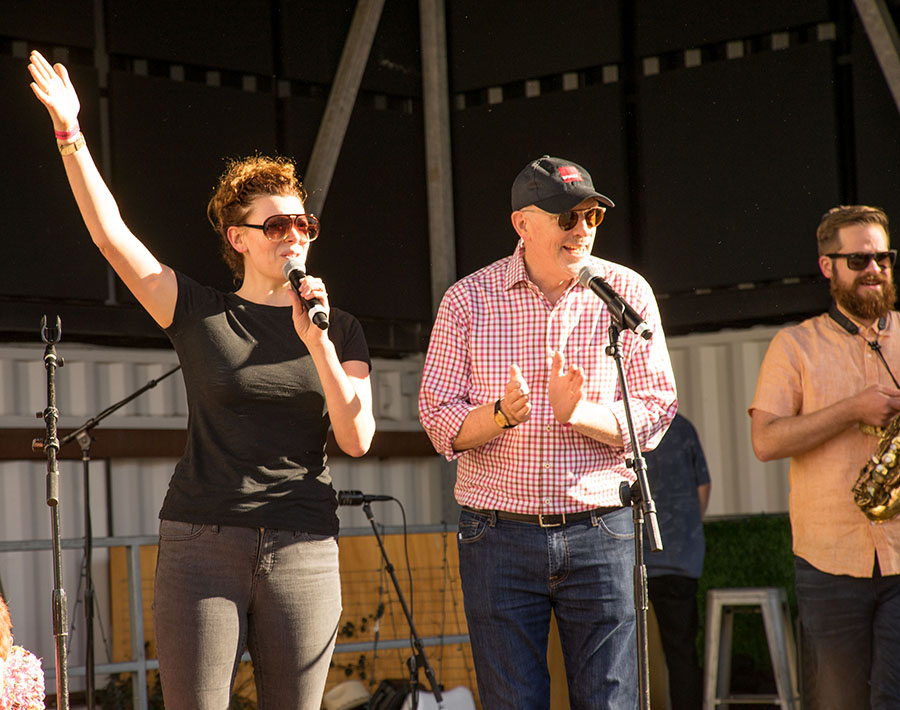
Atkinson announcing the Festival of New Trumpet Music West at the Quartyard w Stephanie Richards, 2019. Photo by Juanita LaHaye.
Like many musicians, my first memories of music were in the church. My family was very active in the Lutheran church, which has a very profound musical tradition going back to J.S. Bach and even earlier. This gave me a foundational experience of participating in music as an expression of worship within a faith community.
My parents were also classical music lovers and subscribers to the San Diego Symphony, so my brother and I grew up listening to symphonic music, both live and recorded. I also have vivid memories of having been taken to see touring productions at the Civic Theater, including Ravi Shankar and the flamenco virtuoso Sabicas.
When I was five years old I met my oldest and closest friend, whose family lived just up the street from our home. His parents were members of an early music group called the Festival Consort, which recorded two albums on the Musical Heritage Society label and played live music for the Shakespeare productions at the Old Globe. I used to love to sit in on their rehearsals, literally under the music stands. My friend and I used to joke that we were the first generation to grow up listening to 16th century music since the 16th century.
When did the guitar become important for you? What were you listening to during the formative years?
I acquired my first guitar for my eighth birthday. My mother gave me a choice of which instrument I was going to learn, I think assuming that I would choose the piano. But it was 1968, so of course it had to be the guitar! I remember my first lessons focused on Beatles tunes, “House of the Rising Sun,” and so on, but I pretty swiftly switched over into classical music, particularly Renaissance music. Composers for the lute and vihuela, like John Dowland and Luis Milan, where some of my early favorites. I have to confess that I was pretty much a classical music snob as a teenager, so I missed out on most of what was going on at that time, aside from the soundtrack of hit tunes and ranchero music on AM radio, which was everywhere.
Where did you go to college and what was your major?
I went to Clairemont High School, graduating one year before Cameron Crowe’s famous undercover assignment at the school that led to his series of articles in Rolling Stone, which became Fast Times at Ridgemont High. Many of the characters in the film are very recognizable to me.
I went to Pomona College, a small liberal arts college in Claremont (minus the “i”) east of L.A. David Murray and John Cage are a couple of famous alumni of the school. I started out as an English major but switched over to philosophy in my second year. While I was at Pomona I was active in the college choir and the Glee Club. I remember performing “Les Noces” for the Stravinsky Centennial at the L.A. County Museum’s Monday Night Concert series. I also continued my study of classical guitar and of the lute. I think my high point as a performer came when I played the Vivaldi lute concerto on guitar with some of the string players from the college orchestra.
I went on to graduate school at Stanford after a few years’ break after Pomona. There, I was in an interdisciplinary program in humanities with a focus on German studies. Outside of my academic work, I also had some of my first important experiences with jazz at that time, attending concerts at the old Yoshi’s in Oakland, Kimballs West, and the Great American Music Hall.
What took you to Europe? How serious was your relationship with the guitar at that point?
At Pomona I became immersed in studying the German language and in reading both fiction and philosophy in German, so I elected to study abroad in what was still the divided Berlin in 1980. I spent a lot of time on both sides of the Wall and had the privilege to experience Brecht’s plays at his own Berliner Ensemble Theater. My study of the early 20th century in Germany and my daily experience of the very visible ruins from WWII, plus the very heavy Soviet presence, had a profound effect on me and changed my outlook on politics, the US, and countless other things in life.
Describe what led you to jazz and how that changed your life.
While I was studying in Berlin, I had the good fortune to take guitar lessons with a superb musician from the West Berlin onservatory, the Hochschule der Kuenste. His name was Klaus-Dieter Schutze. In addition to the lessons, he also liked to hang out and talk a bit before I headed home on the subway. One day he asked me what I thought of John Coltrane and jazz in general, and I swiftly told him that I did not listen to that kind of music. He just as swiftly told me that I was a fool to be ignorant of my country’s greatest contribution to world culture. That scolding propelled me to where I am today!
I heard that Coltrane became important to you. Coltrane is a big subject; what have you learned since that initial exposure?
Well, I have to share a major aha moment that occurred a few years later after my time in Berlin. I was at my closest friend’s place in Berkeley, the same friend whose parents were part of the early music ensemble. His landlady’s teenaged daughter burst in at one point and said something like “you guys have to listen to this” and put on an LP of Coltrane’s called Lush Life. That album is definitely minor stuff in the Coltrane canon, but I was and still am absolutely blown away by Coltrane’s solo on the title tune. So beautiful, so free… I went on to acquire a taste for his later work only gradually but came to love A Love Supreme, Meditations, etc. Curiously, too, I think the spiritual side of Coltrane brought me back in a sense to my musical roots in the church; it was like I knew what he was aiming for from having had the same sort of ecstatic experience listening to Bach.
Do you feel that your ears kept growing as time goes by? Is there stuff that you couldn’t handle initially that you really dig now?
Absolutely. I feel like my ears are constantly evolving. The “out” end of the jazz spectrum continues to challenge and amaze, and I think that reaction is part of what it means to be engaged with that music. I have gained so much from having had the opportunity to experience this music live with the artists at UCSD, people like Mark Dresser, Anthony Davis, Stephanie Richards, and, formerly, George Lewis. And, oddly, on another end of the spectrum, since during the pandemic I have also become obsessed with Bossa Nova, which is not hard to listen to but is a challenge to get inside of as a player.
Jazz promoter Dan Atkinson is another reason that jazz is flourishing in San Diego’s vibrant music scene. Dan brings cutting-edge world-class performers from all over the world to perform in San Diego at various intimate venues through the Athenaeum and his San Diego Jazz Ventures non-profit organization. In addition to this, he is also a guitarist and vocalist, whom I have had the pleasure of working with—both as a teacher and also performing together. I have known Dan for many years; we are good friends, and we are very lucky to have him in our community.
—ROB THORSEN, bassist, educator
When did you get the job at the Athenaeum? Could you name your favorite shows?
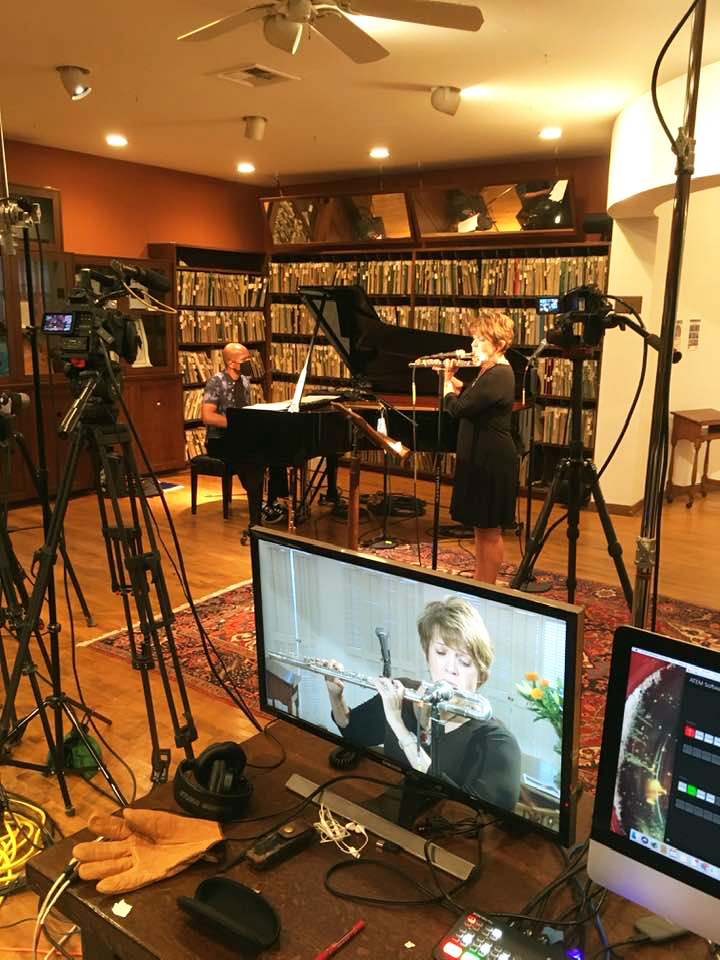
Taping a show at the Athenaeum with Holly Hoffman and Joshua White.
I first came to the Athenaeum in the summer of 1988. I had been working in San Francisco for an arts organization called American Inroads that was sort of a mega version of San Diego’s Sushi Gallery—it was all about cutting-edge avant garde dance, performance art, theatre, and some music. The organization eventually had to disband, in part due to the Black Monday stock market crash of 1987, so by the beginning of 1988 I was looking for a new job. I heard about the opportunity at the Athenaeum through a friend who was on the board of trustees. The Athenaeum was on the verge of a major expansion into the portion of the building that for decades had been the La Jolla branch of the public library. So, everything was poised to gear up at that point. I came in at first to write some grant applications and swiftly became involved in membership development, PR, and program development.
My first program in jazz was a lecture series that took place in January and February, in 1989. It featured two talks by Duke Ellington biographer and producer Stanley Dance, who had retired to Vista, and a talk by George Varga, who invited pianist Harry Pickens to join him. These talks and Harry’s live performance lit the spark and by that summer the first series of Athenaeum jazz performances, curated by Harry, marked the beginning of the series. Later, in 1996, we added the concerts at auditorium at the Neurosciences Institute, now Scripps Research, and then, in 2001, we started the concerts at the Art Studio on Park Boulevard, now relocated to Bread & Salt.
I don’t have a precise count on the number of concerts, but a good estimate would be 450-500 among all three venues.
It is always hard to pick favorites, but for today, I will just grab a few that come to mind:
Fall 1994—The opportunity to work with Charles McPherson has been one of the highlights of my career. I remember so many great moments with Charles, but what comes to mind is a series of evenings that he curated with special guests Teddy Edwards, Conte Candoli, and Buddy Collette. I will never forget Charles and Buddy playing chorus after chorus together of Mingus’ “Nostalgia in Times Square.”
May 1997—a special concert called Flute Summit that Holly Hofmann organized. It featured music for four flutes with Holly, Buddy Collette, Paul Horn, and Steve Kujala, including arrangements and tunes by Buddy that stemmed from his 1958 album called Swinging Shepherds. Flute heaven! Holly has remained a constant friend and source of inspiration to me for the entire run of the Athenaeum Jazz Series.
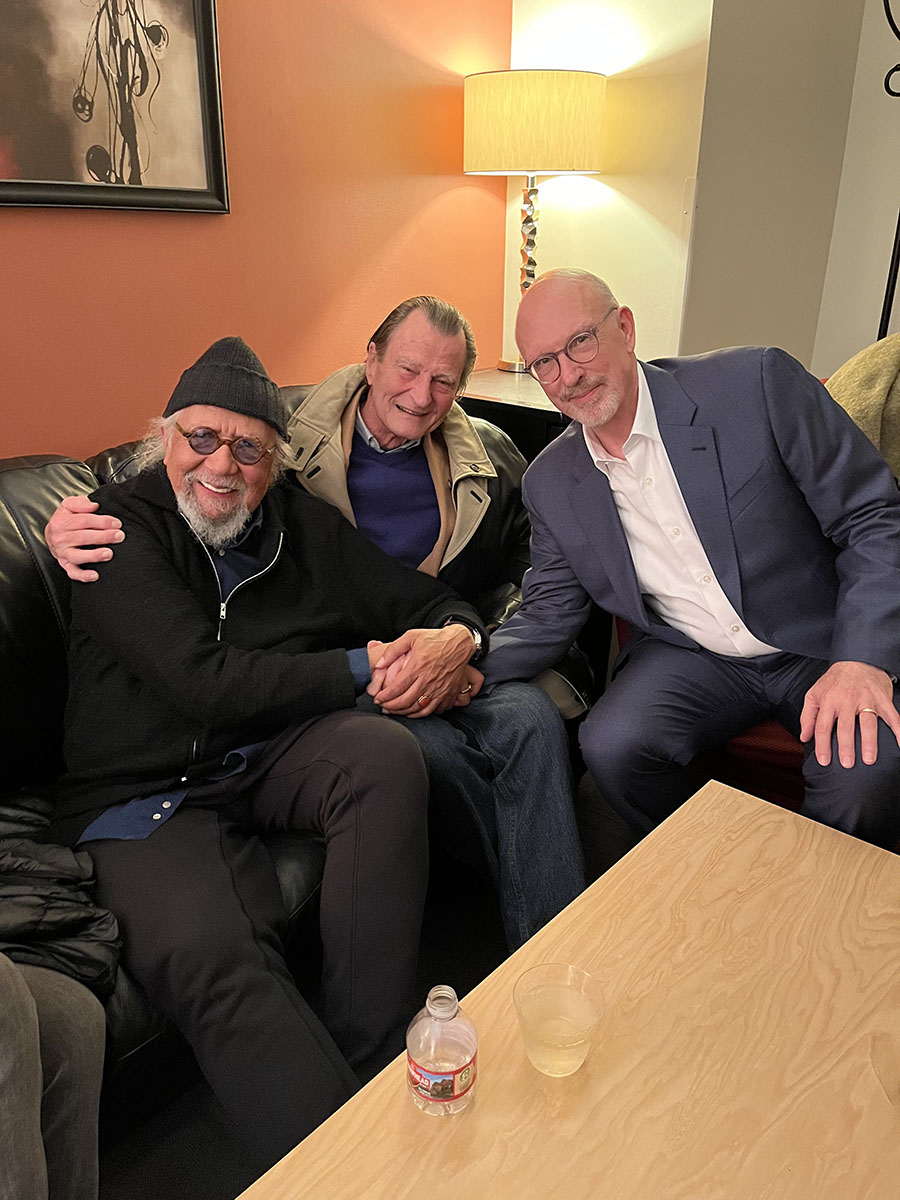
With Charles Lloyd and Al Rubottom backstage at the Athenasum.
April 1998—our first concert with Charles Lloyd, in a quartet with Swedish pianist Bob Stenson, Darek Oles on bass, and Billy Higgins on drums. It was a particularly joyous night because it marked the first reunion for Lloyd and Higgins after Billy had gone through an organ transplant. At one point the two of them descended from the stage and proceded up the stairs and around the audience playing Hungarian taragato and an African drum. Unforgettable!
January 1999—our first concert with Brad Mehldau, in a duo with Darek Oles at the library. This was the beginning of a decades-long relationship between the Athenaeum and Brad. He remains one of my favorite artists, truly an exceptional genius who has expanded the music from his own unique perspective. It was thrilling to hear him at this early stage of his career and in such an intimate setting.
November 2003—The artistry of the wonderful Mike Wofford has been a constant for me for the past three decades. He has played so many stellar evenings for the series, including gigs with artists like Bud Shank, Lee Konitz, Frank Morgan, and many others. Thankfully, one of these was issued as a commercial release called “Live at Athenaeum Jazz,” documenting Mike’s marvelous trio with Peter Washington and Victor Lewis.
July 2013—our first concert with Allison Miller’s Boom Tic Boom band, with Donny McCaslin on tenor sax, Ben Goldberg on clarinet, Myra Melford on piano, and Todd Sickafoose on bass. Allison brings pure joy and total virtuosity to her performances. This particular gig featured an extended high-velocity exchange of solos between Allison and Donny that took the roof off of the Athenaeum.
May 2013—Anthony Wilson’s Seasons Guitar Quartet, with Chico Pinheiro, Julian Lage, and Larry Koonse. Gorgeous music and interaction among four of the greatest guitarists on the scene right now. I have been an advocate for Anthony’s music for a lot of years now but as a guitarist myself, this one was so memorable.
October 2018—Cornetist Ron Miles’ Circuit Rider Trio with Bill Frisell on guitar and Brian Blade on drums. Three absolute masters interacting on an extremely high level. Very delicate music that still had tension and drive. Ron’s passing during the pandemic was a hard loss, he was truly a poet of the music.
How did the job at UCSD come about? Let’s talk about the UCSD jazz camp. What was your goal, and do you have any favorite memories?
In 2000, I left my staff position at the Athenaeum although I remained on a contract basis as the director of the jazz program. I spent most of that year working in a start-up technology venture that had invented a new kind of recording microphone. The sound quality was exceptional, as evidenced by the fact that we received a Grammy nomination for one of our first commercial releases, an album called Standards with Peter Erskine, Alan Pasqua, and Dave Carpenter. In spite of this, we struggled to find a market for the mic, so by the summer of 2001 I found myself out of a job. I learned of a position at UCSD through a couple of friends, and serendipitously the person who was hiring was a longtime Athenaeum jazz audience member, Mary Walshok, dean of UCSD Extended Studies and Public Service.
So, by the fall of 2001, I took on the position of director of arts, humanities, languages, and digital arts at UCSD Extension. I directed a portfolio of Extension courses ranging from digital photography and oil painting to writing the novel to beginning Farsi to UX design. My best estimate is that these courses reached around 80,000 enrollees over a decade and a half.
When I was first hired, I brought two new ideas to the job that I was able to initiate in 2003. One was a distinguished speakers program called the Revelle Forum. This ran for 13 years and gave me the opportunity to host people like Joan Didion, David Rockefeller, Margaret Atwood, and Salman Rushdie for talks that drew their audience from the community as well as the campus. Eventually I also became responsible for the Helen Edison Lecture Series, which continued this work with talks by Bryan Stevenson, the Dalai Lama, John Lithgow, and others.
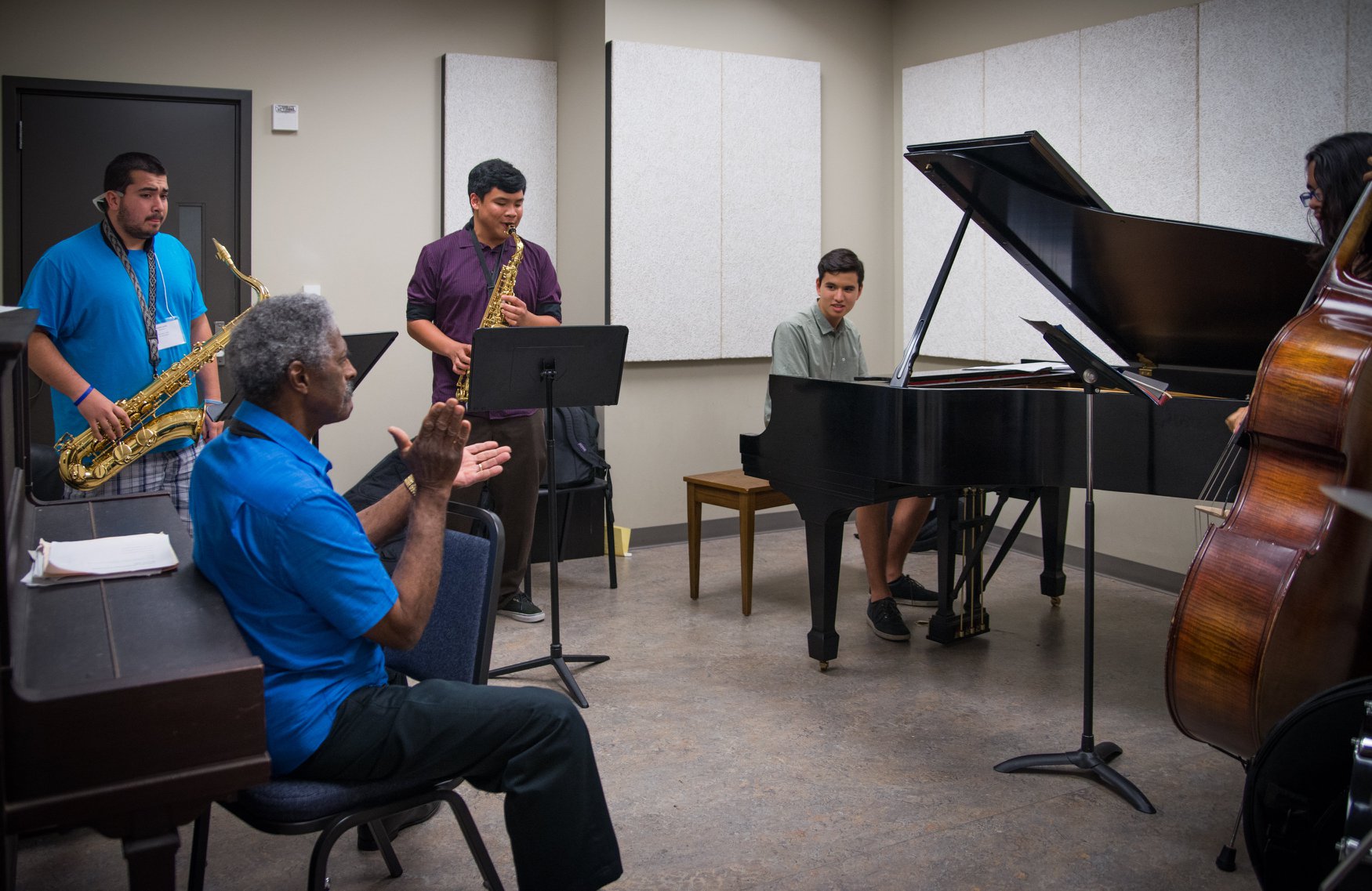
UCSD Jazz Camp with Charles McPherson.
My other new program idea was the UCSD Jazz Camp. I had become very familiar with the Stanford Jazz Workshop in the Bay Area, a historically influential program now in its 50th year that mostly serves high school-level music students. My idea was to create a smaller version of the program that really focused on putting students together in bands for an intensive week-long immersion in jazz. I ran the camp for 16 years and am very proud of both the students and the faculty that were engaged in the program. Three professors from UCSD’s music department were at the core of this effort: David Borgo, Anthony Davis, and Mark Dresser. They brought their unique perspectives to the program as well as connections to other musicians like Gerry Hemingway, Myra Melford, and Wadada Leo Smith.
I am still in touch with many of the students, several of whom are now very active in careers in music. Foremost of these is Joshua White, who attended the first three years of the camp and then eventually returned as part of the faculty. In the first year that Joshua attended the camp he had only limited experience with jazz and was focused on playing the flute, not piano. His brilliance was apparent from the beginning. Another alumnus of note is L.A.-based indie music artist Sam Gendel. I had a chance to reconnect with Sam a few years back when he was playing a gig at the Blue Whale. I could not have been prouder when he told me that his experience in the camp had been decisive in influencing him to pursue a career in music. And, more recently, another alum, NYC-based saxophonist Zoh Amba, has become a very celebrated young artist. It was a thrill to read about her in the New York Times last fall.
How did it end and why?
In 2018 my position at UCSD changed, and my duties became totally focused on preparing for the new Park & Market building in the East Village in downtown San Diego. The jazz camp was an exceptionally labor-intensive project and also a break-even proposition financially, so the decision came down that we would have to suspend and then retire the program. It was a heartbreaker for me to see it go, but I do understand the decision in the context of everything else that was happening.
What was it like being a jazz presenter over the years? Most favorite and least favorite?
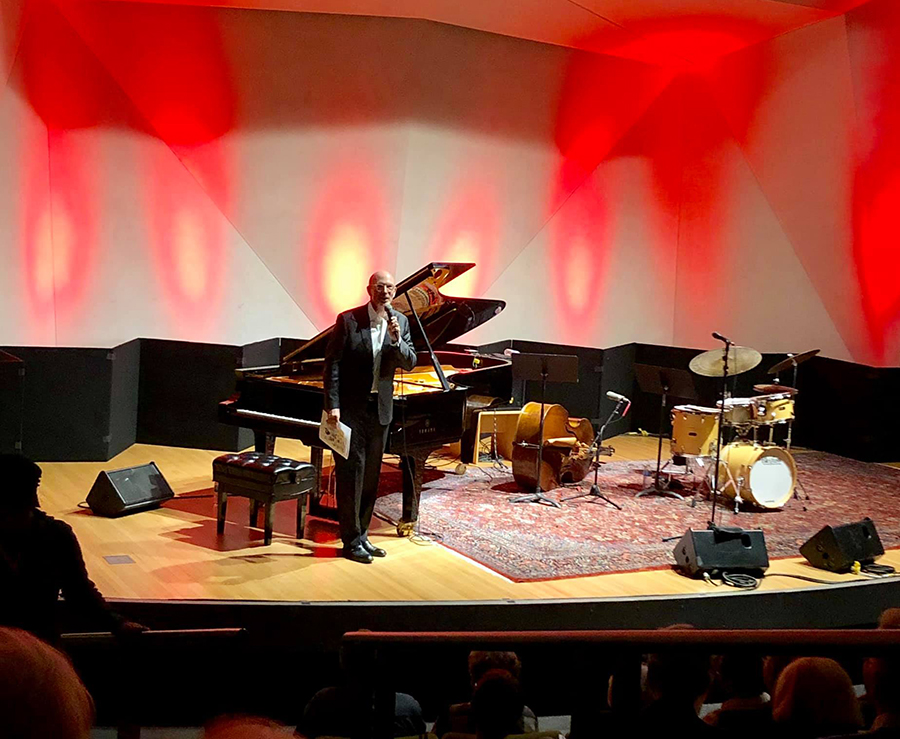
Without question the greatest pleasure that I get as a presenter is in creating an experience of community, both with the artists and with the audience members. It is a show business cliché to end a concert by saying “you’ve been a great audience,” but at the Athenaeum the artists really mean it. I hear this over and over again that the experience of playing here is really special. Myra Melford, who tours extensively around the globe, once told me that we are her favorite place to play in the US. And I recall Bennie Maupin saying that we were like his other favorite venue, a festival that takes place in a small village in Austria. This is all about the interactive vibe that a small venue enables to happen, and about the passion of our audience members who signal to the players that they are really getting it and are primed for more!
Also on the positive side, I get a real thrill from sharing discoveries with our audience. People like Quebecoise pianist Marianne Trudel, Norwegian drummer Thomas Stronen, Colombian harpist Edmar Castaneda, Chilean guitarist Camila Meza, and many American artists who are emerging onto the scene. In part because of my experiences attending the annual Jazzahead conferences in Germany, I have come into an orbit in jazz that is international in scope. I find it truly inspiring to hear what people from all over the globe are doing with this music.
Talk for a minute about the Western Jazz Presenters.
I have been involved with the Western Jazz Presenters Network almost since its beginning in the mid-1990s. We are a nonprofit association of more than 40 jazz festivals, concert series, and clubs ranging from Vancouver and Edmonton in the north to Tijuana in the south, and from up and down the West Coast all the way east to Tulsa and Minneapolis. We typically meet in person only twice a year, once in New York City during the APAP conference and once at SFJAZZ in San Francisco, but we also hold meetings on special topics via Zoom and have a constant flow of communication through our members email listserv. While we deal with a lot of issues common to presenting music in this art form, our primary focus is on building block bookings to facilitate tours for artists in the greater western region. Some of these tours are informal, simply built on information sharing. Others have funding from agencies like the National Endowment for the Arts and the Duke Foundation.
Via the WJPN, it has been a privilege to learn from and collaborate with colleagues in the field like Randall Kline at SFJAZZ, Tim Jackson at the Monterey Jazz Festival, the late Ken Pickering at the Vancouver International Jazz Festival, John Gilbreath at Seattle’s Earshot Jazz, Lowell Pickett at the Musical Instrument Museum in Phoenix and the Dakota in Minneapolis, and Tom Guralnick at the Outpost in Albuquerque, just to name a few. Most of the presentations that I bring to the Athenaeum are in connection with dates at these other venues.
For more than 20 years I was what we jokingly called the “treasurer in perpetuity” on the board of the WJPN. When I retired from UCSD in 2020, I took on a new role as executive director of the organization. I am very proud of meetings that I chaired during the pandemic when the whole music industry was turned upside down. And also, of the grants that I secured from the NEA, which last year funded gigs and outreach activities in 12 different cities by vibraphonist Joel Ross and coming up this year, will bring pianist Sullivan Fortner to gigs in 12 cities throughout the West.
The impact Dan Atkinson has had on San Diego over the past three-and-a-half decades is a profound one that has immeasurably enriched our community. His expert curation of concerts at the Athenaeum, TSRI Auditorium, Park & Market, Studio, Bread & Salt, Qualcomm Hall, the Alexandria, the Quartyard, the San Diego Library, and other area venues has been done with impeccable skill and imagination. Thanks to him, San Diegans have been able to attend myriad performances by national and international jazz artists, many of whom would not have appeared in San Diego were it not for Dan bringing them here.
Better yet, Dan has consistently struck a balance between presenting legends (including McCoy Tyner, Chick Corea, Charles Lloyd, Carla Bley) and future legends who made their San Diego debuts under Dan’s auspices (Brad Mehldau, Lionel Loueke, Linda May Han Oh, Chris Potter). He’s also showcased hundreds of veteran artists who, while maybe not quite legends, are the backbone of jazz. And he’s featured Charles McPherson, Holly Hofmann, Mike Wofford, Gilbert Castellanos, and other jazz greats who happen to live in San Diego.
He cares deeply about art and has been a tireless champion of great jazz from around the world. For musicians and concert goers alike, Dan has provided so much. I can’t imagine what San Diego would be like without his dedication and many, many contributions.
—GEORGE VARGA, San Diego Union Tribune music critic, Jazz Times contributor
You were in on the planning stages of UCSD Extension’s Park and Market building downtown. Now that it is open, what do you think?
I was a tireless advocate for the arts presence in the Park & Market building, in particular for the Guggenheim Theater, which is a very fine listening room that is just beginning to have its impact on the local scene. I look forward to seeing the program grow and develop there and expect to be presenting some concerts in the space myself.
Let’s talk about San Diego Jazz Ventures? How did it come about and where do you hope it’s going?
My other post-UCSD project (in addition to the directorship of the WJPN) was to found a new nonprofit organization with a specific mission to present jazz in the greater San Diego-Baja region. For years I had been frustrated by the fact that for every show I booked for the Athenaeum, there were four or five other artists for whom I did not have a slot on the series. I gathered a few friends together back in 2018 to begin discussing what we might do to expand the jazz scene, including both individual concerts and the longtime dream of hosting an international-level jazz festival in our town.
SDJV’s first gig was to have taken place on April 5, 2020. Given the pandemic, we had to cancel and wait until the end of the summer of 2021, when we officially launched with outdoor concerts by Ben Williams and Gretchen Parlato. We followed these up last June with concerts by the all-women sextet Artemis and by vocalist Thana Alexa.
Last summer the board and I decided to take inspiration from the World Design Capital designation for San Diego-Tijuana in 2024 as the impetus to create a cross-border jazz festival. We are all in now on planning and raising funds to make this happen in fall 2024.
Let’s talk about the new bi-national project that you have planned.
Here is some background. Part of the mission of the UCSD Park & Market building is to increase ties and cooperation among San Diego, Baja, and Mexico. So, as part of the runup to the opening of Park & Market, I began actively to form relationships with artists and arts institutions in Tijuana.
My first efforts on this began in early 2018, when I crossed all of my hats—UCSD, Athenaeum, and WJPN—in organizing a five-city tour by the NYC-based Mingus Dynasty band to play Mingus’ “Tijuana Moods” suite. The US cities—Tucson, Phoenix, San Diego (on the Athenaeum series), and Portland—were easy; all the presenters were members of the WJPN. The Tijuana date on the tour was essential to me given the focus of the music, but it took literally nine months to get the date confirmed.
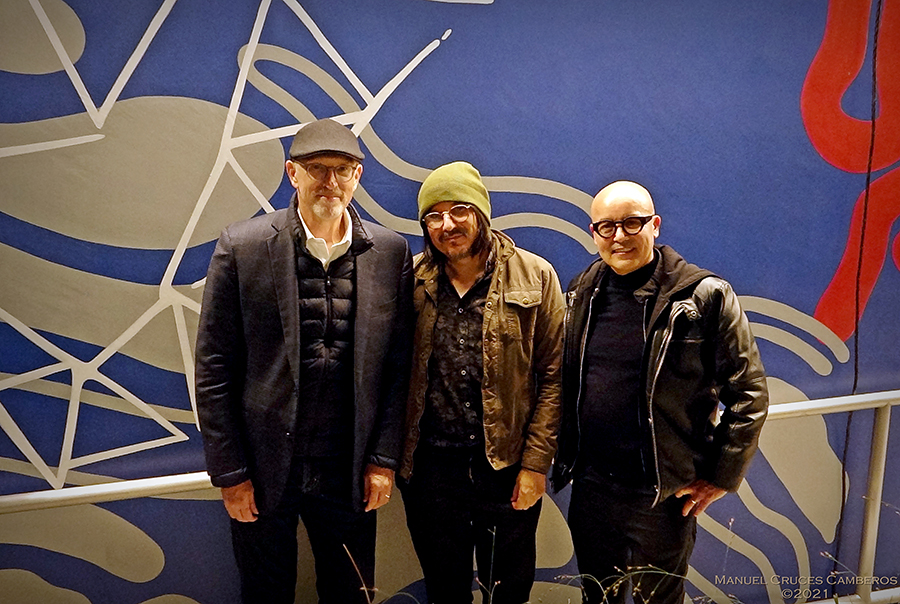
With Pepe Mogt and Ramon Amezcua of the Nortec Collective at Park & Market, 2020. Photo by Manuel Cruces Camberos.
The key facilitator in this effort was Ramon Amezcua, more widely known as Bostich of the Grammy-nominated electronic music group the Nortec Collective. I had met him years before when his son was a student in the UCSD Jazz Camp. Ramon immediately understood the importance of the Mingus project for Tijuana and took steps to introduce me to Pedro Ochoa, who was then the director of the CECUT cultural center. Another key player in this effort was Julian Plascencia, director of the Tijuana Jazz and Blues Festival. With Julian’s support and Ramon’s intervention, we eventually secured a date at the CECUT that attracted a crowd of more than 600 people. The atmosphere in that room was electric!
This experience led me to follow up with three concerts in downtown San Diego, featuring the Nortec Collective, two of them premiers of new works by Nortec and also to present the US debut of the La Covacha Big Band from Ensenada, led by Nortec’s trumpeter, Ivan Trujillo.
Mexico and Baja specifically have been a part of my life for almost as long as I can remember. I recall the days that my parents would pile the family into the station wagon and drive down to TJ. It required only a driver’s license to cross in those days. I think my college experience of the Berlin Wall gave me a perspective on what has become a more and more restrictive and militarized border here, as has my ongoing acquisition of greater knowledge of Mexican history and culture. I have also had the benefit of collaborating with other presenters across the US and Canada, and of seeing how the European countries work together on cultural projects. To me, San Diego’s position on the border is one of its greatest assets.
So, when San Diego and Tijuana were designated as the World Design Capital for 2024, it seemed natural to design a festival that would link both cities together culturally and celebrate their joint heritage. A key input for this came late last summer when Julian Plascencia mentioned to me that one of the primary originators of jazz—New Orleans pianist Jelly Roll Morton—had lived, played, and composed in Tijuana in the early 1920s during the Prohibition era. This is almost completely unknown history that links our border region to the roots of jazz.
As of this time (June 2023), we are still confirming a lot of details, so unfortunately it is a bit too soon to share specifics about the program. What I can say is that I have the good fortune to work with a team of artistic advisors from both side of the borders—Gilbert Castellanos and Kamau Kenyatta from San Diego, and Julian Plascencia and Ivan Trujillo from Baja—plus some significant partnering organizations in both cities. It is a big, complex effort involving many players, but I think it will say something profound about who we are as a region and what we share across this border.
San Diego Jazz Ventures’ vision is to continue with the festival on either an annual or bi-annual basis, with future editions that will focus on jazz legends with local roots, like Harold Land and Arthur Blythe, and on the many styles and schools of jazz from all over Latin America and the Caribbean. I got to thinking recently about how diverse these influences are and about how, over the years, I have had the chance to present artists from all over this hemisphere, including Argentina, Chile, Peru, Brazil, Colombia, Panama, Venezuela, Puerto Rico, Cuba, Trinidad, and probably more. There is a huge amount of music to explore and celebrate and San Diego’s position on the northern edge of this vast region puts us in the perfect position to do this.
How does it feel being selected as a jazz hero from the Jazz Journalists Association?
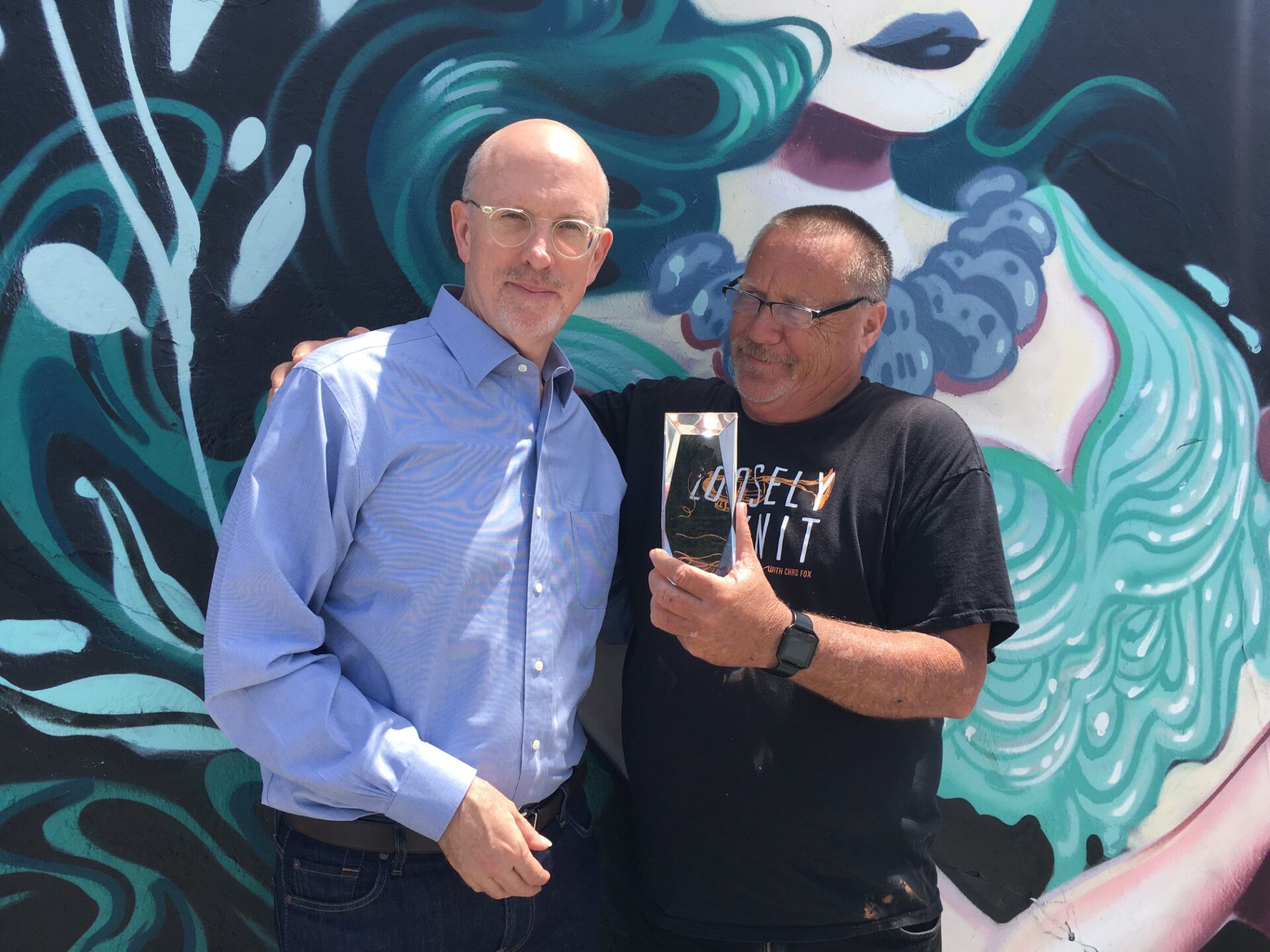
Jazz writer Robert Bush presenting Atkinson with the Jazz Hero Award.
For me it was a great honor to be selected as a Jazz Hero by the JJA. This is both a local and a national designation since the nominations are submitted by each city and are then approved at a national level. Each year’s class of Jazz Heroes shows how much passion and dedication are needed, and how many different roles must be filled, to keep this music thriving in communities all across the US. Jazz is truly a labor of love, which is one reason that jazz truly feels like a family. In my experience, I can walk into any jazz venue in the country and find someone there with whom I share only one degree of separation. How wonderful is that?
Let’s talk about the “not so young lions.” What does that mean to you?
I was honored when my longtime friend Gilbert Castellanos asked me to serve on the board of his Young Lions Jazz Conservatory. I like to think that Gilbert’s experience as an essential member of the UCSD Jazz Camp faculty contributed in part to his development of this program. You can see these bands of amazing young players performing every Wednesday at Panama 66 and just be in awe of how talented and professional they are—as teenagers!
The adult version of the program had been under discussion for a while, and I think in part due to all the woodshedding that went on during the pandemic, there was a lot of demand for this. So YLJC opened the first adult classes in the fall of 2022. I have spent one night a week for most of the past year trying to work my way into playing this music after having been only a listener for 40+ years. My bands have included physicians, attorneys, software engineers, biotech scientists, and educators. This experience has given me even greater admiration for the artists and also for the young Young Lions, who are truly phenomenal!
What is your relationship to the guitar nowadays?
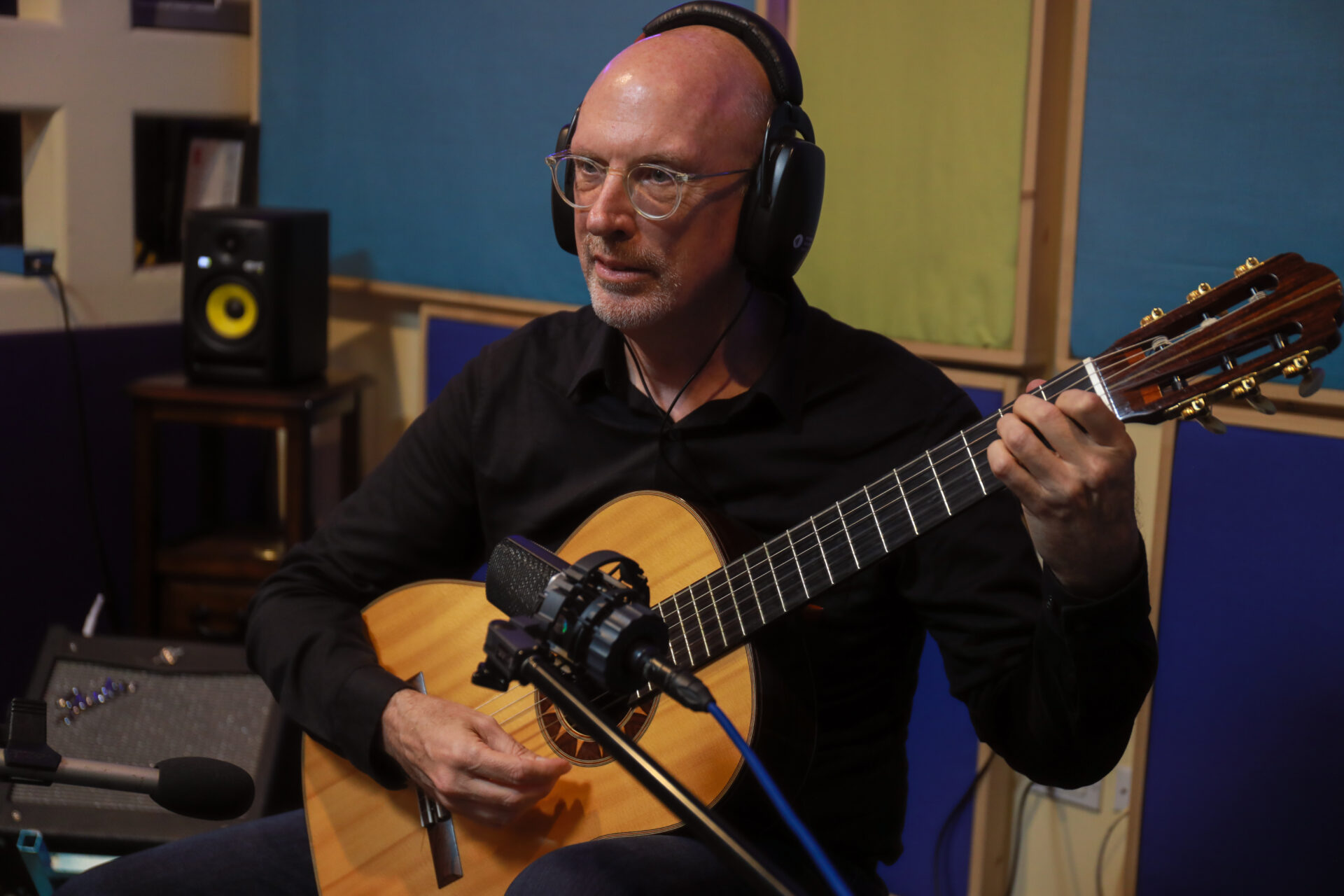
Atkinson at a recording session in Tijuana. Photo by Jay Prieto.
I had been a very serious classical guitar player for a lot of years, then completely dropped out of playing music during my 40s. I returned to it only when my wife, Jennifer, conspired with a good friend of ours to purchase an exceptional guitar for me. Jennifer knew that I was missing an outlet for my own music making, so this was a major turning point in my life. But I still was playing only classical music. Somehow even with the resource of the jazz camp at my fingertips, I had treated playing jazz as a kind of third rail not to be touched. This changed during the pandemic when my friend, bassist Rob Thorsen, had the exceptional generosity of spirit to invite me to come over and play music with him in his front yard. Rob’s patience and mentorship meant the world to me, particularly during such trying times, and he managed to propel me into taking a whole new approach to my musical expression. I will be forever indebted to him!
I had always been drawn to Brazilian music, particularly Bossa Nova, so this has become my focal point as a player and as a vocalist, too. Joao Gilberto’s solo albums are a primary inspiration—so cool and fluid—and as I have come to learn, so deceptively simple sounding!
What is coming up (post-August) in 2023?
After a nearly four-year gap, this fall we are finally going to return the Athenaeum Jazz Program to the Scripps Research auditorium, which has been closed, first due to the pandemic and then to a major construction project adjacent to the theater. I have to confess, it has required a lot of patience to get to this point. We presented the first three public concerts in that hall in the fall of 1996 and had a continuous series there through the fall of 2019. Then there was nothing, aside from a brief break in 2021. It is a space that I have truly loved to program in, a true gem for San Diego. So, for our return—from September through February—we will feature three concerts with artists including Regina Carter, Etienne Charles, and Brad Mehldau. Hopefully, this will mark a return to what was our normal pattern of programming up until the pandemic.
What is the future for Dan Atkinson?
I hope to continue with what I am doing now—the Athenaeum series, the festival, and the WJPN—for a lot of years to come. That is a full slate and a very full and rich life for me.
Dan Atkinson has been a key figure in the elevation of the San Diego music scene for many years. Whether producing concerts featuring some of the world’s best musical artists or spearheading transformative educational programs such as the UCSD Jazz Camp, Dan has worked tirelessly to help move San Diego into the forefront of the music scene.
—JOSHUA WHITE, piano virtuoso, composer
You seem so calm and soft spoken… is that the complete picture of Dan Atkinson? Do you ever get pissed off or really excited about something? What would make you raise your voice? Do you ever let loose with a juicy obscenity?
Okay, so go ahead and embarrass me. My family background is such that histrionics are not smiled upon. That being said, I can also be pushed beyond my limits. I think needless and obtuse obstructions are what irritate me the most. At UCSD, I used to flip out over the bureaucracy that would get in the way of getting simple things done. Like the year we were informed that the dorms for the jazz camp students had been moved to the far side of the campus. Or the disbursement procedures that would mysteriously change without notice after having remained the same for years. Yes, I admit it, there was profanity! I also had an “assistant” on the Athenaeum concerts who would go AWOL at crucial moments, leaving me to do his job for him. I remember cursing him out before one concert after a particularly abysmal instance of this. The sound engineer for that night looked at me afterwards with a slight smile and said, “So… you can go there after all”!
On the positive side, after Charles Lloyd’s concert this spring at the Qualcomm Auditorium, I was so moved that I was unable to speak while the audience was leaving the hall. And I had a similar reaction after hearing Bryan Stevenson’s UCSD talk about his work in social justice. People like this are truly exceptional, even angelic, beings and I feel so fortunate to have had the opportunity to bring them to our community.
A WORD FROM THE AUTHOR
I began this project several months ago with a nagging sense of urgency. I was feeling ill and though this cover story was my idea (recognition for Dan Atkinson is always overdue because he’s earned it). I wanted to get started as early as possible, knowing that my health might prevent me from finishing it.
So, there is good news and bad news. The good news is that I am writing this under my own volition, which makes me very happy. The bad news is that my feeling of unwellness was prescient, if not prophetic: bottom line, I have Stage 4 cancer, which has spread to other organs, so I don’t have a lot of time left.
But this isn’t about me.
I have always felt a profound sense of gratitude to the wonderful and brave souls that we call concert promotors. In my lifetime as a San Diego jazz enthusiast, this appreciation began with the intrepid pioneer Rob Hagey, who curated so many fantastic shows for the La Jolla (then San Diego) Jazz Festival. I will never forget seeing Old & New Dreams, the cooperative trio Air (Henry Threadgill, Fred Hopkins, and Steve McCall), Jan Garbarek, Anthony Davis, and Jack DeJohnette all courtesy of Mr. Hagey, who absolutely changed my life through his tireless advocacy on behalf of creative music.
There are few unsung heroes more unsung than the proprietor of Dizzy’s, Chuck Perrin. For decades he has toiled in a variety of venues bringing the best in local and national name acts to our little town. He’s the ultimate one-person juggernaut—doing everything from booking the acts to putting away the chairs at the end of each concert.
When Brian Ross was at the UCSD nightspot, The Loft, he brought everyone from Joshua White’s myriad ensembles to vocalist Alicia Olatuja into the student-run venue. For experimental music on the cutting edge, there was no finer advocate than Bonnie Wright. Her Fresh Sound Series featured everyone from Vinny Golia to Steve Lacy and beyond. And then there is Dan’s contemporary, Holly Hofmann, who brought folks as diverse as Dave Holland and Joe Henderson to San Diego to be heard in a super intimate context.
Every one of those above mentioned made my life demonstrably richer, and Daniel Atkinson has been doing so for the past 35 years. He has consistently encouraged me as a writer and, in the larger scheme of things, turned out to be a true friend, someone I could turn to and count on while I recently languished for three weeks in the hospital.
He’s a class act all the way—a true gentleman and a scholar and the very definition of a renaissance man.





